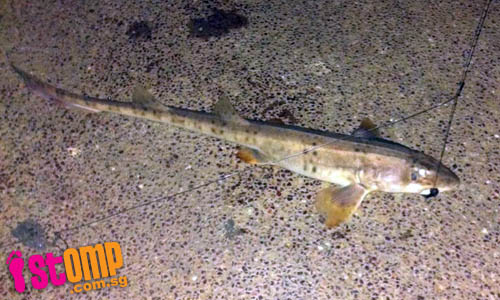
STOMPer Leezmic was jogging at Punggol End when he saw an uncle pulling up this baby shark from the waters.
The STOMPer writes:
"I was having a jog with a friend on Jun 11 at Punggol End when I saw an uncle pull up this baby shark.
"I'm surprised to see these fish in Singapore waters."
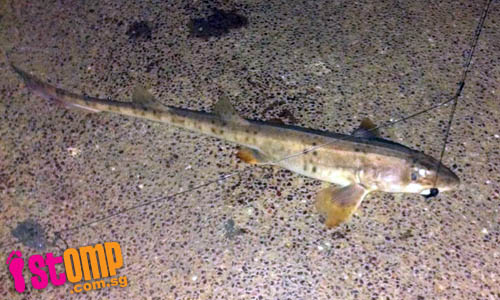

Fishing is one way in which ordinary members of the public can end up discovering more about the marine life that still inhabits our waters. Many people don't realise that the murkiness doesn't mean that the seas around this island are lifeless.
The shark pictured appears to be a slender bamboo shark (Chiloscyllium indicum). A small species which grows up to 65 centimetres in length and inhabits sandy coastal waters, it is not surprising that this shark is occasionally caught by anglers at places like Changi.
Bamboo sharks belong to the family Hemiscyllidae, and are sometimes also known as longtail carpet sharks. Related to more famous species like nurse sharks (F. Ginglymostomatidae) and wobbegongs (F. Orectolobidae), these are small bottom-dwellers with most species maxing out at less than a metre in length. They spend the bulk of their time on the seabed, often hiding in crevices or among coral rubble, and feed primarily on small benthic fishes and invertebrates. What's interesting is that bamboo sharks possess sharp teeth suitable for grabbing soft-bodied prey, but because these teeth are not fixed in place, they can actually fold backwards, turning into crushing plates for smashing the shells of crustaceans and molluscs.
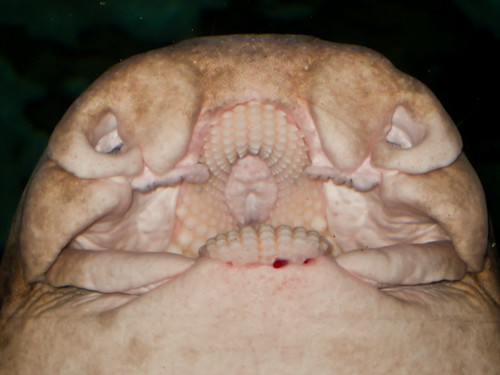
(Photo by tobze)
There are a number of online forums for local anglers to talk about fishing and to share their memories of fishing sessions and trips. This thread on Fishing Kaki and this other thread on Handline Fishing both show photos of what appear to be slender bamboo sharks caught at Changi.

(Photo by VeryOn, from Fishing Kaki)


(Photos by Kaix, from Handline Fishing)
Four other species of bamboo shark have been recorded to occur in Singapore, the grey bamboo shark (Chiloscyllium griseum), Hasselt's bamboo shark (Chiloscyllium hasselti), white-spotted bamboo shark (Chiloscyllium plagiosum) and brown-banded bamboo shark (Chiloscyllium punctatum).


This live bamboo shark has been tentatively identified as a Hasselt's bamboo shark;
(Photos by Angelfishing, from Handline Fishing)


Brown-banded bamboo shark (?);
(Photos by Angelfishing, from Handline Fishing)


Although the sharks in these photos have also been identified as brown-banded bamboo sharks, I'm inclined to think that they are more likely to represent slender bamboo sharks;
(Photos by Angelfishing)
Due to their relatively small size and a tendency to inhabit shallow lagoons and tidal pools, bamboo sharks are able to do reasonably well in captivity, and are among the few species available to private hobbyists.
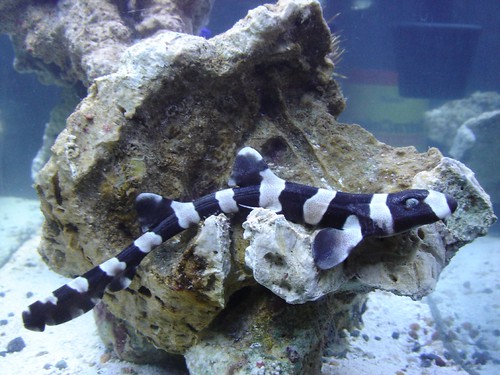

Young brown-banded bamboo sharks being kept in aquaria;
(Photos by shanahanlim and Ashley Anne!)
Needless to say, they do still require lots of care in terms of living conditions; captive bamboo sharks need very large tanks that can provide both ample swimming space and adequate (and stable!) rockwork or other tank decor to provide hiding places, excellent filtration, and proper diet. They are docile and can be kept with fishes too large for them to eat; however, a bamboo shark may be at a disadvantage during feeding time and be outcompeted or even bullied by quicker and more aggressive tankmates, hence the use of feeding tongs or a skewer to deliver food directly to the shark is recommended. Any smaller fish and invertebrates are of course destined to eventually become food for the bamboo shark.
Under the right conditions, one may even be able to breed bamboo sharks in captivity. Mating is similar to that seen in other sharks; the male subdues the female by biting one of her pectoral fins, then inserting one of his claspers into her cloacal opening.
Many shark species give birth to live young, but bamboo sharks lay eggs, depositing a handful of egg cases on the seabed. In a study, a female grey bamboo shark laid only 27 eggs over the course of 3 months, releasing a pair of eggs every 2-9 days.

(Photo by Doug Perrine)
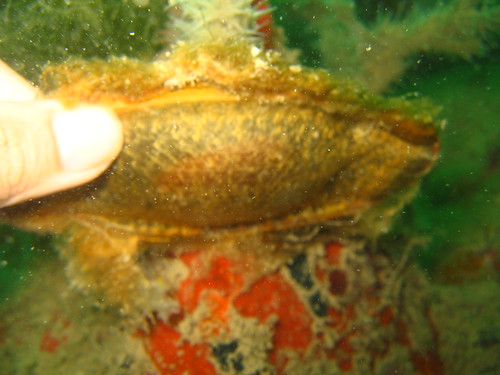
Shark egg case, possibly that of a bamboo shark, found at Pulau Hantu;
(Photo by Debby)
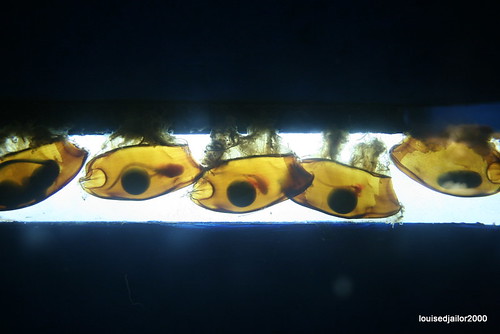
Manila Ocean Park;
(Photo by louisedjailor2000)
The egg hatches a few months later (67-85 days according to the abovementioned study), and the tiny pup emerges.

Infant white-spotted bamboo shark emerging from egg case;
(Photo by Mark Conlin, from ARKive)
Many aquarists choose to buy a bamboo shark when it is still developing in the egg, and give the shark a bit of assistance when it's time to hatch.
Bamboo sharks are so inoffensive that in many public aquariums, including our very own Underwater World Singapore, they are exhibited in touch pools, allowing visitors to pat and stroke them. Of course, one shouldn't even attempt to lift a bamboo shark out of the water (they are still quite powerful and can thrash about), or stick one's fingers into its mouth.

(Photo by Mauldinovci)

(Photo by 唔得闲的咸咸)
Some of us have encountered bamboo sharks while scuba diving in Singapore waters!
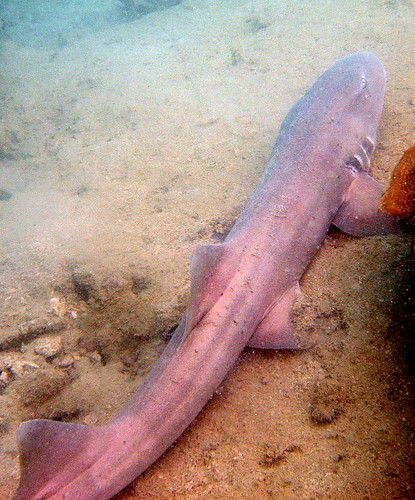
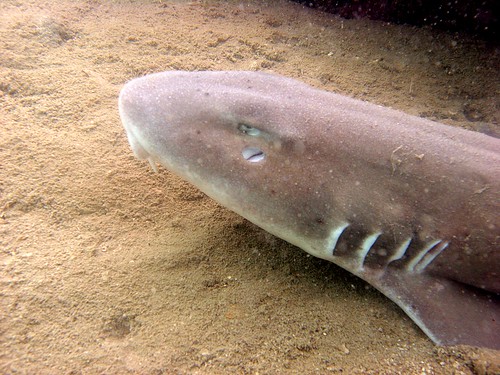
I think this bamboo shark seen at Pulau Hantu is an adult brown-banded bamboo shark;
(Photos by Chay Hoon)
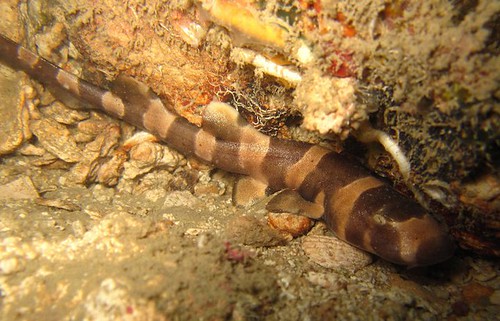
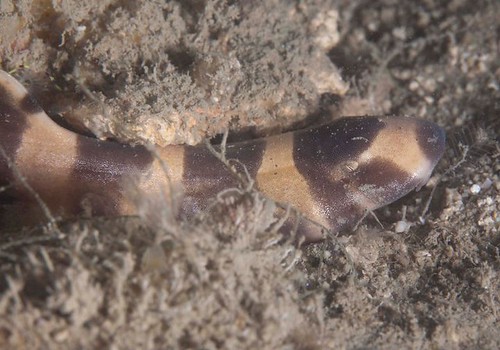
These baby bamboo sharks were also seen at Pulau Hantu. Likewise, I'm not sure if they are grey or brown-banded bamboo sharks (baby grey bamboo sharks also have brownish bands);
(Photos by Debby)

This one released from a bubu trap at Pulau Hantu is clearly a white-spotted bamboo shark;
(Photo by Geraldine Lee)
I had my own very special encounter with a bamboo shark that I released from a bubu trap on Cyrene Reef.

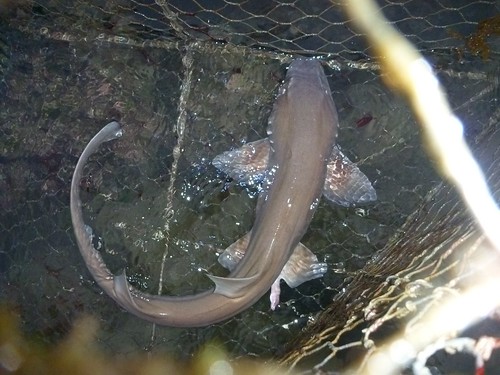
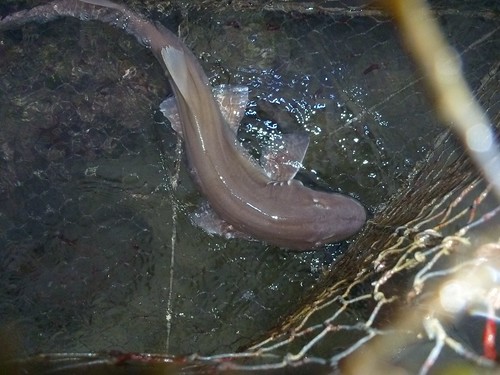
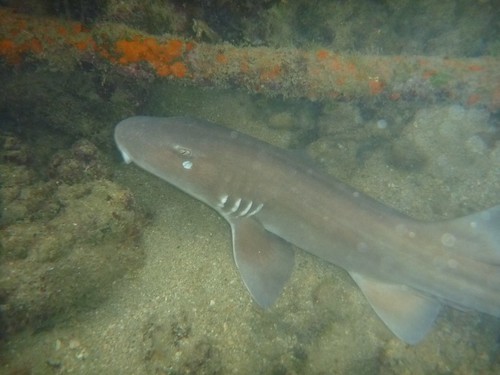
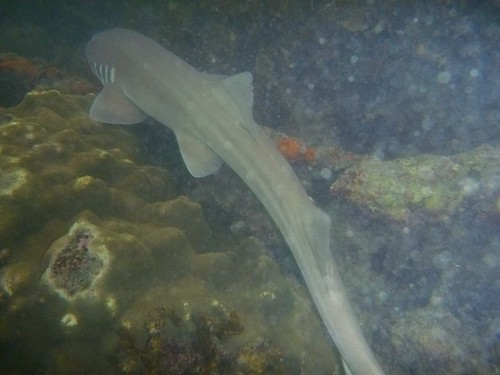
Chay Hoon also once found a baby bamboo shark on an intertidal trip at Beting Bronok.

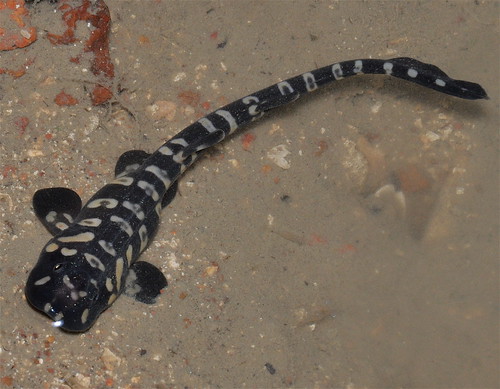
Based on the photos here and here, this might be a baby Hasselt's bamboo shark;
(Photos by Chay Hoon)

Subadult Hasselt's bamboo shark (?);
(Photo by krj-1168, from WaterWolves)
Besides these occasional sightings, most local records of bamboo sharks seem to come from anglers and other recreational fishermen. All five species of bamboo sharks recorded in Singapore are considered to be Near Threatened on the IUCN Red List.
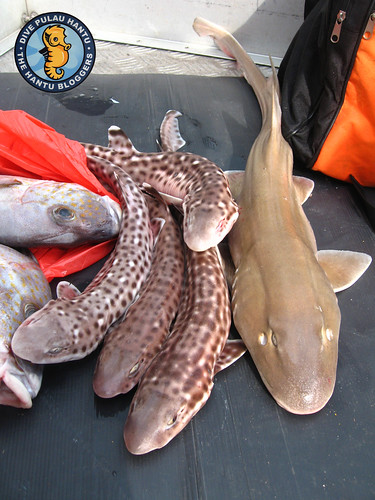
Debby found this grey bamboo shark (?) and 4 coral cat sharks (Atelomycterus marmoratus) as part of someone's catch from St. John's Island;
(Photo by Debby)
The following are selected photos of bamboo sharks caught by anglers from all around Singapore (although locations are understandably vague and probably known only to people within the inner circles), and uploaded to the Fishing Kaki forums:

'Jurong Island offshore';
(Photo by SAL)

'Drifting from Pasir Panjang to Palawan Beach, Sentosa';
(Photo by SeaGuardians)

'Marina';
(Photo by Amuro Ray)

'West side of Singapore';
(Photo by SpinMaster77)

'Southern part of Singapore';
(Photo by Firdaus)

'Offshore';
(Photo by king.tay)
Some of the bamboo sharks caught are apparently quite small:

'Sister's Island';
(Photo by Saw Ee)
Nobody knows the population status of the various bamboo shark species found in Singapore, and whether the current rate at which they are being caught is sustainable. There are some anglers who advocate catch and release whenever bamboo sharks are hooked (usually by accident when other more valuable bony fishes are desired), although there are others who still prefer to keep and consume their catch. And even if the sharks are released back into the sea, it is not known how many of them are able to survive the trauma. Perhaps it may be good to develop a set of guidelines on how to ensure a high survival rate when catch and release is practised, as well as a recommended minimum size, with any individual bamboo sharks falling below this size being released alive within a reasonable timeframe.
Earlier this year, several divers at Pulau Hantu found the carcasses of 3 bamboo sharks. 2 of them had torn mouths, suggesting that they either broke free from a hook but died, or were discarded by an angler.


(Photos by Petrus Sahetapy)
Bamboo sharks can also be found alive in Sheng Siong supermarkets, where they apparently feed a demand for fresh shark meat (shark flesh spoils quickly if not processed properly and immediately).

Live bamboo sharks and a tawny nurse shark (Nebrius ferrugineus) seen for sale at a Sheng Siong supermarket;
(Photo from my paper, on SoShiok)
Much has been said about Singapore's role in the shark fin trade, but perhaps we might need to also pay a bit more attention to whether the local recreational fishing community is able to accept the responsibility of adopting best practices to help ensure that vulnerable species like sharks are being fished sustainably.
The bamboo sharks belong to a family that is part of the group of sharks generally known as the carpet sharks or Orectolobiformes, a group composed chiefly of bottom-dwelling species. Besides the 5 species of bamboo sharks, Singapore is known to be home to 2 other much larger species.
The fishing community provided an excellent recent record of a tawny nurse shark caught in Changi in 2009, and what a whopper it was!

(Photo by bluewater_legends)


(Photos by S,ian)
This large nurse shark was eventually released, after a restaurant owner helped secure its freedom by paying the people who had netted it.
Similarly, based on this record from 2007, the zebra shark (Stegostoma fasciatum) probably still occurs in Singapore.

(Photo by aj123)
Unlike the nurse shark though, this zebra shark was kept for consumption.
There is one other orectolobiform shark that leads a very different lifestyle from the rest of the group, being a truly gigantic pelagic plankton-feeder. A particularly noteworthy report of a whale shark (Rhincodon typus) in Singapore waters can be found in the Straits Times in June 1964; a 6 metre long whale shark had gotten trapped in a kelong near Pulau Sebarok, and was shot by marine police. This decision to kill a gentle giant drew criticism, but was defended by the curator of the Van Kleef Aquarium, saying that the people involved acted out of a sense of duty and couldn't have known better. The whale shark carcass was handed over to the University of Singapore, and I'm really curious as to whether the specimen has been lost, or if it's still in the zoological collections of the Raffles Museum of Biodiversity Research.


The whale shark at Clifford Pier;
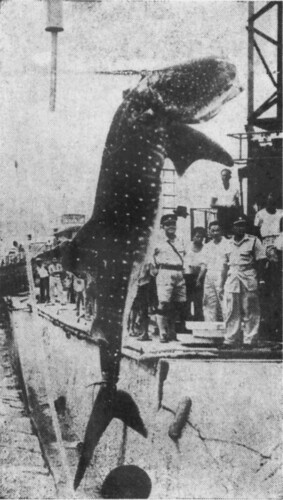
The whale shark at Tanjong Rhu;
Besides the carpet sharks, the rest of the shark species reported in Singapore belong to the ground sharks or Carcharhiniformes, the group encompassing requiem sharks (F. Carcharhinidae), hammerhead sharks (F. Sphyrnidae), weasel sharks (F. Hemigaleidae), and cat sharks (F. Scyliorhinidae).
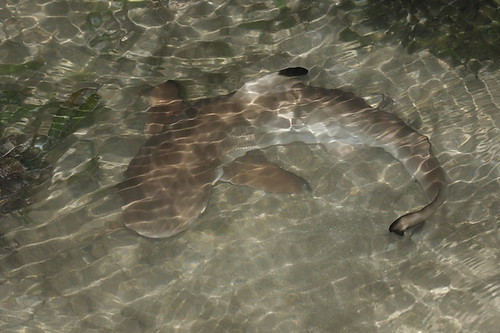
Black-tipped reef shark (Carcharhinus melanopterus), Pulau Senang;
(Photo by James)
Based on occasional sightings by shore explorers and divers, and catch reports by anglers, we know that 3 species from the ground shark group, the coral cat shark, black-tipped reef shark and blackspot shark (Carcharhinus sealei), are still extant in local waters. However, we know nothing about the status of the remaining 18 species of ground shark, which includes large, potentially dangerous species like the scalloped hammerhead (Sphyrna lewini), grey reef shark (Carcharhinus amblyrhynchos), and tiger shark (Galeocerdo cuvier). Gone are the days when large sharks were routinely caught in Singapore Harbour, and fishermen, divers, and swimmers risked being attacked, even close to shore.
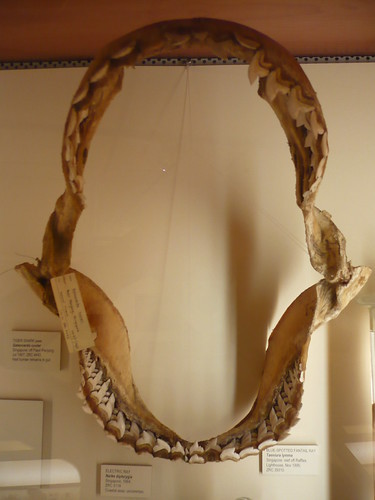
Jaws of a tiger shark that was caught off Pasir Panjang in 1967, now on display at the public gallery of the RMBR. Human remains (said to comprise two arms, a leg, and ribs) were found inside this particular individual;
There is also a very interesting record of a shortfin mako (Isurus oxyrinchus) being caught in Singapore Harbour, the sole record of the mackerel sharks (Lamniformes) in Singapore.
More about these other sharks another time.